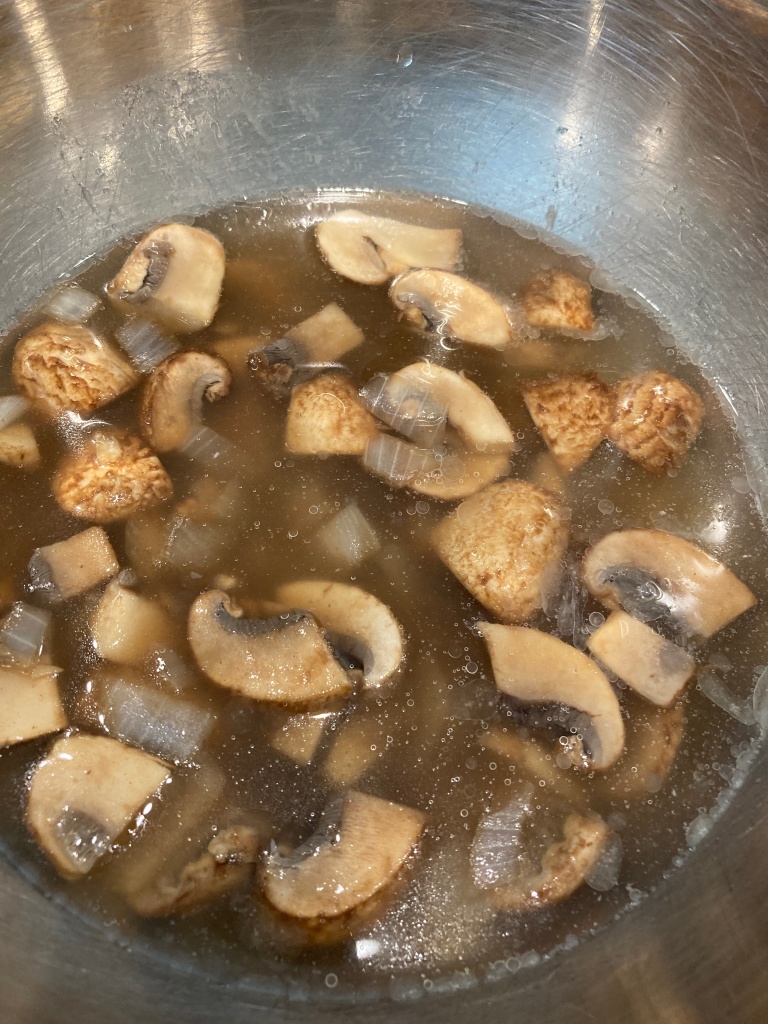The evenings are getting colder and darker. That cues in me the desire to move away from salads and fresh greens toward creamy, warm, comfort food. This recipe for Sirloin Stroganoff will definitely be on my family’s menu this fall.
COST COMPARISON OF SIRLOIN TO GROUND BEEF
Growing up, when we had Beef Stroganoff, it was always made with ground beef. If cooking with supermarket beef, that is definitely the most economical way to make this dish. But remember, if you purchase a quarter or half cow from a local farmer, you receive a wide variety of cuts for one low price. Consider this example below.
Grass-fed ground beef at the supermarket might average $6.99 a pound. Grass-fed sirloin at the supermarket might average $12.99 a pound. For both of those, I feel we must define the “grass-fed” claim. Currently, a “grass-fed” label in the supermarket is almost meaningless. No one inspects the claim. And to complicate matters further, any cow can be considered “grass-fed.” They all eat grass at some point in their lives, even the ones that are finished on a feed lot. The only label that holds any weight in the supermarket is “American Grass-Fed Approved.” This label is checked. It means that the cattle have never been in a feed lot. They have only been fed grass, forage, and mother’s milk. The catch is, I’ve never actually found this label in the supermarket.

When you purchase beef from a local farm, you know the quality of the meat and the conditions in which the animals are raised.
Now, if you were to purchase a quarter cow from Spring Forest Farm, you might spend around $7.60 per pound, on average, for all of the cuts of beef that come in your order. (This is the price from a 2023 steer.) It does make ground beef more expensive on average, but it makes the other, more expensive cuts quite accessible. Pasture raised and finished Filet Mignon for $7.60 a pound? Yes, please! Also, when you purchase from a local farm, you know the quality of the meat and the conditions in which the animals are raised. The allusive “American Grass-Fed Approved” label isn’t necessary.
While I grew up eating Ground Beef Stroganoff, Sirloin Stroganoff is accessible to even a moderate budget when beef is purchased in bulk from a reputable, regenerative farm like Spring Forest Farm.



TRADITIONAL STROGANOFF SAUCE
Traditional Stroganoff sauce is made from Worcestershire sauce, beef stock, dijon mustard, corn starch, heavy cream, and sour cream. In the sauce, aside from the beef, you’ll also find onions, garlic, and mushrooms.
I’ve adapted this sauce for three reasons. Worcestershire sauce generally contains gluten as it’s traditionally made with barley malt. To avoid this ingredient, I substitute balsamic vinegar, “No Soy” sauce, and a bit of ketchup in its place. Also, I don’t keep GMO products in my kitchen, so in place of corn starch, I use arrowroot powder.

After searing the steak, cook the onions, garlic, and mushrooms. Use the balsamic vinegar and “No Soy” sauce to deglaze the pan.
The third adaptation is to replace the dairy with a non-dairy option. I love the creaminess of traditional dairy products. There are tons of recipes on the internet that provide directions for using dairy in Beef Stroganoff. While I indulge in dairy products occasionally, I often find that dairy increases inflammation in my body. For this reason, I like to have a dairy-free option available to me.
DAIRY-FREE OPTIONS FOR STROGANOFF SAUCE
Whenever I’m cooking something “dairy-free” that needs a rich, creamy gravy, I like to begin by pureeing vegetables. In this recipe, I simply portion off some of the cooked onions, garlic, and mushrooms to blend into the beef stock. This make a good base for any other additions.

I puree half of the cooked vegetables in beef stock to form the base for dairy-free gravy.
To add to the creaminess of the gravy, you can use coconut cream or unflavored, unsweetened coconut yogurt. You could also opt for a dairy-free milk like oat or almond milk. I think the fat in coconut cream or yogurt makes a richer, creamier product, but the arrowroot should thicken the sauce enough to use non-dairy milk if that’s a preference. You have options. There are several ways to get to a similar end point.
Enjoy this recipe! And as always, make it your own!
GF and DF Sirloin Stroganoff

Ingredients
– large skillet or pan
– mixing bowl and immersion blender, or standing blender
– 1.5 lbs sirloin steak (can sub ground beef)
– 1/2 tsp sea salt
– 1/2 tsp white pepper
– 1 lb white button mushrooms, sliced
– 2 white onions, diced
– 2-4 garlic cloves, minced
– 2 tbsp olive oil
– 1 tbsp balsamic vinegar
– 1 tbsp “No Soy” Sauce or other soy sauce substitute
– 1 tsp ketchup
– 1 tsp dijon mustard
– 1 1/2 c beef stock (or beef bone broth)
– 1 tsp sea salt
– 2 tbsp arrowroot powder
– 1/2 c unsweetened, unflavored coconut yogurt (see above for more options)
– chopped parsley for garnish and noodles for serving
Directions
1. Prepare all ingredients before cooking. Slice the sirloin steak(s) thin (about 1/4 inch thick) across the grain. Salt and pepper the pieces of steak and allow them to warm to room temperature while you slice the mushrooms, dice the onions, and mince the garlic.
2. Heat a large skillet or pan over medium heat on the stovetop. When the pan is hot, add the olive oil. When the olive oil is hot, add some of the steak. Sear each side of each piece for 1-2 minutes. Do not cook the steak in piles, but in batches, so that the steak can lay flat on the bottom of the pan. When done searing, remove the steak and rest it on a plate to be added back in later.
3. After all the beef has been seared, add the onions and garlic to the pan. Sauté for about a minute and then add the mushrooms to the pan. To help deglaze the bottom of the pan, add the tbsp of balsamic vinegar and tbsp of “No Soy” sauce. Continue to stir everything as it cooks.
4. When the mushrooms are soft and fully cooked, remove 1/3 to 1/2 of the onion/garlic/mushroom mixture and place it in a mixing bowl or blender. Set it aside. Reduce the heat to a low simmer. Add the beef back to the pan. Stir and allow to simmer while you attend to the blending.
5. To the mixture of onion/garlic/mushrooms, add the tsp of ketchup, tsp of dijon mustard, 1 1/2 c beef stock, and tsp of sea salt. If using a mixing bowl, use an immersion blender to blend this mixture until everything is smooth. If you don’t have an immersion blender, use a standing blender to emulsify this mixture.
6. Add the blended “gravy” back to the pan. Stir the beef and gravy to combine. Allow the pan to simmer for ten minutes. This will finish cooking the beef.
7. After simmering, place 2 tbsp arrowroot into a small bowl. Spoon a bit of the liquid from the pan into this bowl and whisk continuously to form a sort of slurry. Add the slurry to the gravy in the pan. The gravy will begin to thicken quickly as you stir.
8. Add the coconut yogurt and stir to combine. Garnish with parsley and serve over noodles.

Here on SpringForestFarm.com, Jennifer Taylor Schmidt writes beef recipes for the busy, natural homemaker. It is possible to seek optimal health with limited time and money. Join Jennifer in future posts as she explores the possibilities found in a 1/4 and a 1/2 beeve. She also offers recipes and nourishment for body, mind, and soul on RealFoodRealHealing.com.
